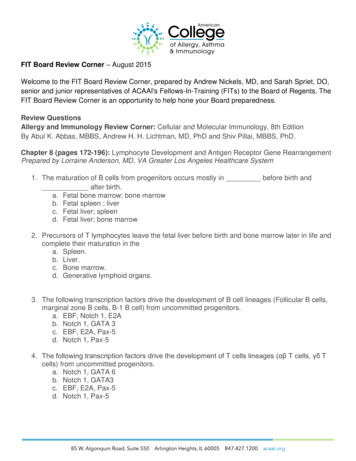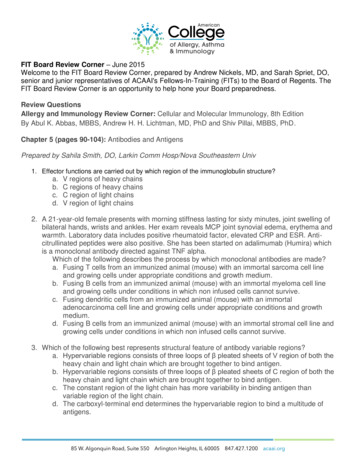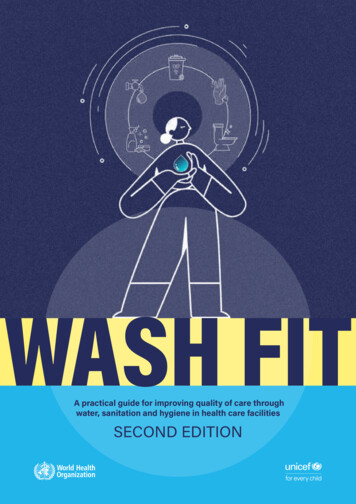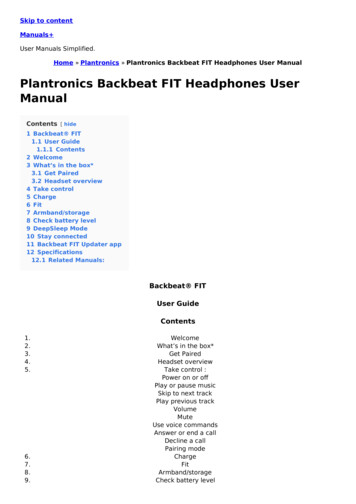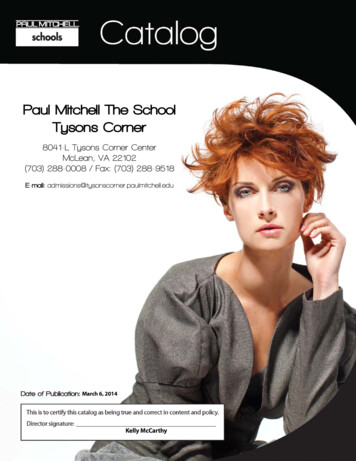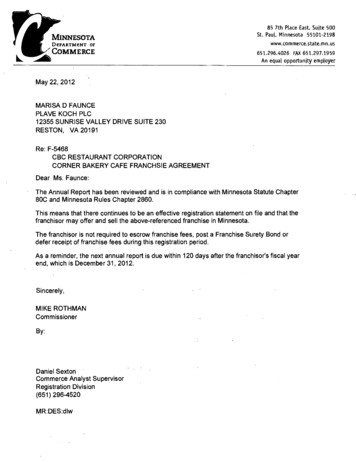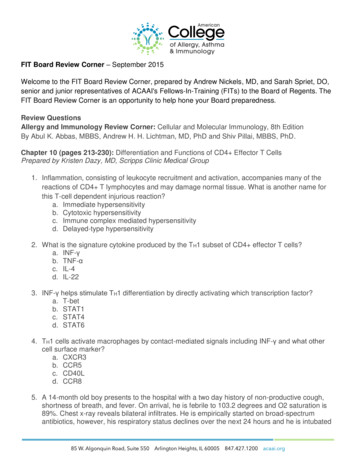
Transcription
FIT Board Review Corner – September 2015Welcome to the FIT Board Review Corner, prepared by Andrew Nickels, MD, and Sarah Spriet, DO,senior and junior representatives of ACAAI's Fellows-In-Training (FITs) to the Board of Regents. TheFIT Board Review Corner is an opportunity to help hone your Board preparedness.Review QuestionsAllergy and Immunology Review Corner: Cellular and Molecular Immunology, 8th EditionBy Abul K. Abbas, MBBS, Andrew H. H. Lichtman, MD, PhD and Shiv Pillai, MBBS, PhD.Chapter 10 (pages 213-230): Differentiation and Functions of CD4 Effector T CellsPrepared by Kristen Dazy, MD, Scripps Clinic Medical Group1. Inflammation, consisting of leukocyte recruitment and activation, accompanies many of thereactions of CD4 T lymphocytes and may damage normal tissue. What is another name forthis T-cell dependent injurious reaction?a. Immediate hypersensitivityb. Cytotoxic hypersensitivityc. Immune complex mediated hypersensitivityd. Delayed-type hypersensitivity2. What is the signature cytokine produced by the TH1 subset of CD4 effector T cells?a. INF-γb. TNF-αc. IL-4d. IL-223. INF-γ helps stimulate TH1 differentiation by directly activating which transcription factor?a. T-betb. STAT1c. STAT4d. STAT64. TH1 cells activate macrophages by contact-mediated signals including INF-γ and what othercell surface marker?a. CXCR3b. CCR5c. CD40Ld. CCR85. A 14-month old boy presents to the hospital with a two day history of non-productive cough,shortness of breath, and fever. On arrival, he is febrile to 103.2 degrees and O2 saturation is89%. Chest x-ray reveals bilateral infiltrates. He is empirically started on broad-spectrumantibiotics, however, his respiratory status declines over the next 24 hours and he is intubated
Page 2 of 7for respiratory failure. Bronchoalveolar lavage is performed and is positive for Pneumocystisjiroveci. On detailed history, you determine that he has been hospitalized several times sincebirth due to severe, recurrent respiratory infections. Immune deficiency work-up has previouslyrevealed low IgG and normal IgM levels. Which of the following is most likely responsible forthis child’s presentation?a. ADA deficiencyb. CD40L mutationc. JAK3 mutationd. STAT3 mutation6. Which of the following transcription factors acts as the master regulator of T H2 differentiationby enhancing expression of the TH2 cytokine genes IL-4, IL-5, and IL-13?a. STAT1b. STAT4c. STAT6d. GATA-37. Which of the following cytokines is responsible for B cell Ig heavy chain class switching to boththe IgE and IgG4 isotypes?a. IL-4b. IL-5c. IL-12d. INF-γ8. What is the major cell type that is recruited by TH17 cells to combat extracellular microbes?a. Neutrophilsb. Monocytesc. Eosinophilsd. Basophils9. Which cytokine is produced by activated TH17 T cells and serves to maintain barrier function ofepithelial tissue, particularly of the skin and GI track, by stimulating repair mechanisms andproducing anti-microbial peptides?a. IL-17b. IL-18c. IL-21d. IL-2210. Which of the following cell types are considered a subset of T cells and are able to recognize awide variety of antigens without a requirement for MHC-associated presentation?a. TH2 T cellsb. αβ T cellsc. γδ T cellsd. TH17 T cellsAnswers
Page 3 of 71. D, page 216.Delayed-type hypersensitivity (DTH) is a term that refers to tissue damage caused by a T cellmediated immune response. DTH frequently occurs together with protective cell-mediated immunityagainst microbes and may be the cause of much of the pathology associated with certain types ofinfections.2. A, page 217.The signature cytokines produced by T cell subsets determine their effector functions and roles indisease. The signature cytokine produced by TH1 CD4 T cells is INF-γ which occurs in response tointracellular microbes that activate dendritic cells, macrophages, and NK cells.3. B, page 219.INF-γ directly activates transcription factor STAT1 which in turn stimulates expression of anothertranscription factor, T-bet. T-bet then promotes INF-γ production through a combination of directtranscriptional activation of the INF-γ gene and by inducing chromatin remodeling of the INF-γpromoter region. IL-12 contributes to TH1 differentiation by binding to receptors on antigen-stimulatedCD4 T cells and activating transcription factor STAT4, which also enhances INF-γ production.STAT6 is a transcription factor involved in production of the T H2 subset of CD4 T cells.4. C, pages 221-222.When TH1 cells are stimulated by antigen, the cells express CD40L on their surface and secrete INFγ. The actions of INF-γ on macrophages synergize with the actions of CD40 ligand and together theyare potent stimuli for macrophage activation. TH1 cells also express high levels of the chemokinereceptors CXCR3 and CCR5 which bind to other chemokines elaborated in tissues during innateimmune responses.5. B, page 222.Inherited immunodeficiencies, as well as gene knockout mice, have established the criticalimportance of CD40-CD40L interactions. X-linked hyper-IgM syndrome results from inheritedmutations in CD40L which makes patients susceptible to infections with otherwise harmlessintracellular microbes, including the intracellular fungus Pneumocystis jiroveci, which require T celldependent macrophage activation in order to be eradicated. As expected, these patients also havedefects in helper T cell-dependent antibody production.6. D, pages 222-223.L-4 stimulates TH2 development by activating the transcription factor STAT6, which, together withTCR signals, induces expression of GATA-3. This transcription actor acts as a master regulator ofTH2 differentiation by enhancing TH2 cytokine genes (IL-4, IL-4, IL-13) which are located in the samegenetic locus. GATA-3 works by directly interacting with the promotors of these genes and also bycausing chromatin remodeling.7. A, page 224.IL-4 stimulates B cell Ig heavy chain class switching to the IgE isotype and also enhances switchingto IgG4 (in humans) and inhibits switching to the IgG2a and IgG2c isotypes (in mice), both of whichare stimulated by INF-γ. IL-13 can also contribute to switching to the IgE isotype.8. A, pages 226-227.
Page 4 of 7TH17 cells combat microbes by recruiting leukocytes, mainly neutrophils, to sites of infection andserve as a major defense mechanism against extracellular bacteria and fungi. IL-17 is produced byTH17 cells and stimulates the production of chemokines and other cytokines that recruit neutrophilsand, to a lesser extent, monocytes to the site of T cell activation. It also enhances neutrophilgeneration by increasing the production of G-CSF and the expression of its receptors.9. DC, page 227.IL-22 is a member of the type II cytokine family. It is produced by activated T cells, particularly T H17cells, and by some NK cells and group 3 innate lymphoid cells. IL-22 is produced in epithelial tissues,especially of the skin and gastrointestinal track, and serves to maintain epithelial integrity, mainly bypromoted the barrier function of epithelia, by stimulating repair reactions, and by induction productionof anti-microbial peptides.10. C, page 228.In addition to CD4 and CD8 T cells, there are smaller populations of T cells that have distinctfeatures and are thought to serve specialized functions in host defense. The best defined of thesesubsets are γδ T cells and NKT cells. Both of these T cell subsets express receptors of limiteddiversity (suggesting that they have evolved to recognize a small group of microbial antigens) and areable to recognize various antigens without a requirement for MHC-associated presentation. They areboth abundant in epithelial tissues, such as the gastrointestinal track.Review Questions
Page 5 of 7Allergy and Immunology Review Corner: Cellular and Molecular Immunology, 8th EditionBy Abul K. Abbas, MBBS, Andrew H. H. Lichtman, MD, PhD and Shiv Pillai, MBBS, PhD.Chapter 11 (pages 231-239): Differentiation and Functions of CD8 Effector T CellsPrepared by Kara Wada, MD, Ohio State Univ/Nationwide Children's Hospital1. Which of the following are mechanisms are employed by viruses in an attempt to evade hostdefenses?a. Viruses reside in the nucleus where they are inaccessible to killing mechanisms.b. Viruses do not use the host cell’s machinery to replicate.c. Viruses use cell surface molecules to gain entry into the host cell.d. Viruses do not alter cell surface molecules of the host cell.2. CD8 T lymphocytes are effector T cells responsible for the following functions:a. Elimination of intracellular microbes, tumor cells and acute organ allograft rejection.b. Elimination of extracellular microbes and tumor cells.c. Elimination of intracellular microbes, tumor cells and chronic organ allograft rejection.d. Elimination of extracellular microbes, tumor cells and chronic organ allograft rejection.3. Cross presentation is a critical step in the antigen presentation to CD8 T cells. Which of thefollowing best explains this process?a. Specialized dendritic cells ingest infected cells, transfer the protein to the cytosol andprocess the antigen to enter the class I MHC presentation pathway for recognition byCD8 T cells.b. Specialized B cells ingest infected cells, transfer the protein to the cytosol and processthe antigen to enter the class I MHC presentation pathway for recognition by CD8 Tcells.c. Specialized dendritic cells ingest infected cells, transfer the protein to the cytosol andprocess the antigen to enter the class II MHC presentation pathway for recognition byCD8 T cells.d. Specialized dendritic cells ingest infected cells, transfer the protein to the cytosol andprocess the antigen to enter the class I MHC presentation pathway for recognition byCD4 T cells.4. CD4 helper T cells are not necessary for CD8 T cell responses in which of the followingcircumstances?a. Latent viral infectionsb. Infection of an antigen presenting cellc. Organ transplant rejectiond. Tumor recognition5. Helper T cells are thought to promote CD8 T cell activation by which of the followingmechanisms?
Page 6 of 7a.b.c.d.Expression of CD40Production of IL-15Production of IL-21Production of TNF-α6. CD8 T cells may be initiated in some chronic viral infections but then gradually diminishesover time. This phenomenon is called:a. Toleranceb. Cross presentationc. Exhaustiond. Consumption7. What functional and phenotypic changes are found in exhausted CD8 T cells?a. Decreased production of INFγb. Decreased expression of PD-1c. Increased production of IL-21d. Presence of natural antibodies that block PD-18. CTL-mediated killing involves a specific series of events initiating with recognition. Which is thecorrect pairing found in the immunologic synapse of CTL-mediated killing?a. Target cell with class I MHC molecule with peptide: LFA-1b. ICAM-1:LFA-1c. ICAM:CD8 coreceptord. ICAM:TCR9. CTLs and NK cells mediate killing through the use of cytotoxic proteins. Which cytotoxicprotein is correctly described?a. Granzymes function analogous to C9 complementb. Perforin functions to facilitate delivery of the other cytotoxic granules into the cytosol ofthe target cell.c. Serglycin is a serine protease that activates caspases.d. Perforin serves to assemble a complex of many different types of cytotoxic proteins10. A patient presents with a history of recurrent Mycobacterial infections, difficult to clear malariaand reactivation of EBV. Which type of immunodeficiency would you be most concernedabout?a. TLR defectb. HIV/AIDSc. CD8 T cell defectd. Macrophage defectAnswers
Page 7 of 71. C, page 231.Viruses have evolved to use various cell surface molecules to gain entry into host cells and then usethe host cell’s machinery to replicate and disseminate from one host cell to the next. They tend toreside in the cytosol thus further avoiding intrinsic microbicidal mechanisms.2. A, page 231.The function of CD8 cytotoxic T lymphocytes include elimination of a variety of intracellularmicrobes, eradication of tumor cells and play critical roles in the acute rejection of organ allografts.3. A, page 232.Specialized dendritic cells ingest infected cells, transfer the protein to the cytosol and process theantigen to enter the class I MHC presentation pathway for recognition by CD8 T cells. See Fig. 6.20.4. B, page 233.The requirement for helper cells varies according to type of antigen exposure. Strong innate responseand direct infection of APCs do not require CD4 help whereas latent viral infections, tumors andorgan transplant responses do required CD4 interactions.5. C, pages 233-4.Helper T cells may promote CD8 T cell activation by secretion of cytokines that stimulate thedifferentiation of CD8 T cells and through expression of CD40L which can bind to CD40 on the APC.IL15 is important for memory CD8 survival but IL21 is known to be produced by CD4 T cells andplays a role in the induction of CD8 T cell memory and prevention of exhaustion.6. C, page 234.Exhaustion is a term that is used to imply that the effector response does develop but then is activelyshut down. This occurs in chronic viral infections.7. A, page 234.Exhausted CD8 T cells demonstrate decreased INFγ and increased expression of inhibitoryreceptors such as PD-1. Presence of IL-21 helps prevent exhaustion from occurring and antibodiesdirected against PD-1 are being considered therapeutically in the treatment of tumors ad chronic viralinfections.8. B, page 235.Target cell with class I MHC molecule with peptide is a ligand for the CR and CD8 coreceptors.ICAM-1 binds to LFA-1.9. B, page 236.Granzymes A, B, and C are serine proteases at cleave proteins and activate caspases, perforinfunctions analogous to C9 complement and also facilitates delivery of other granzymes. Serglycinserves to assemble a complex containing granzymes and perforin.10. C, page 238.CTLs are crucial for host defense against intracellular bacteria, malaria, and latent viral infectionssuch as EBV.
FIT Board Review Corner - September 2015 Welcome to the FIT Board Review Corner, prepared by Andrew Nickels, MD, and Sarah Spriet, DO, senior and junior representatives of ACAAI's Fellows-In-Training (FITs) to the Board of Regents. The FIT Board Review Corner is an opportunity to help hone your Board preparedness. Review Questions
